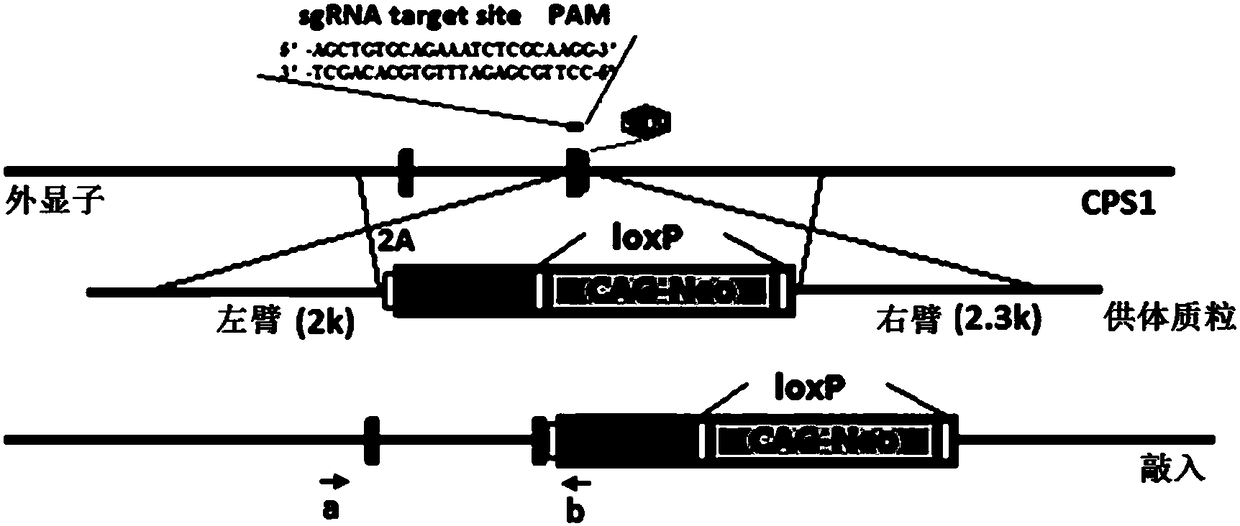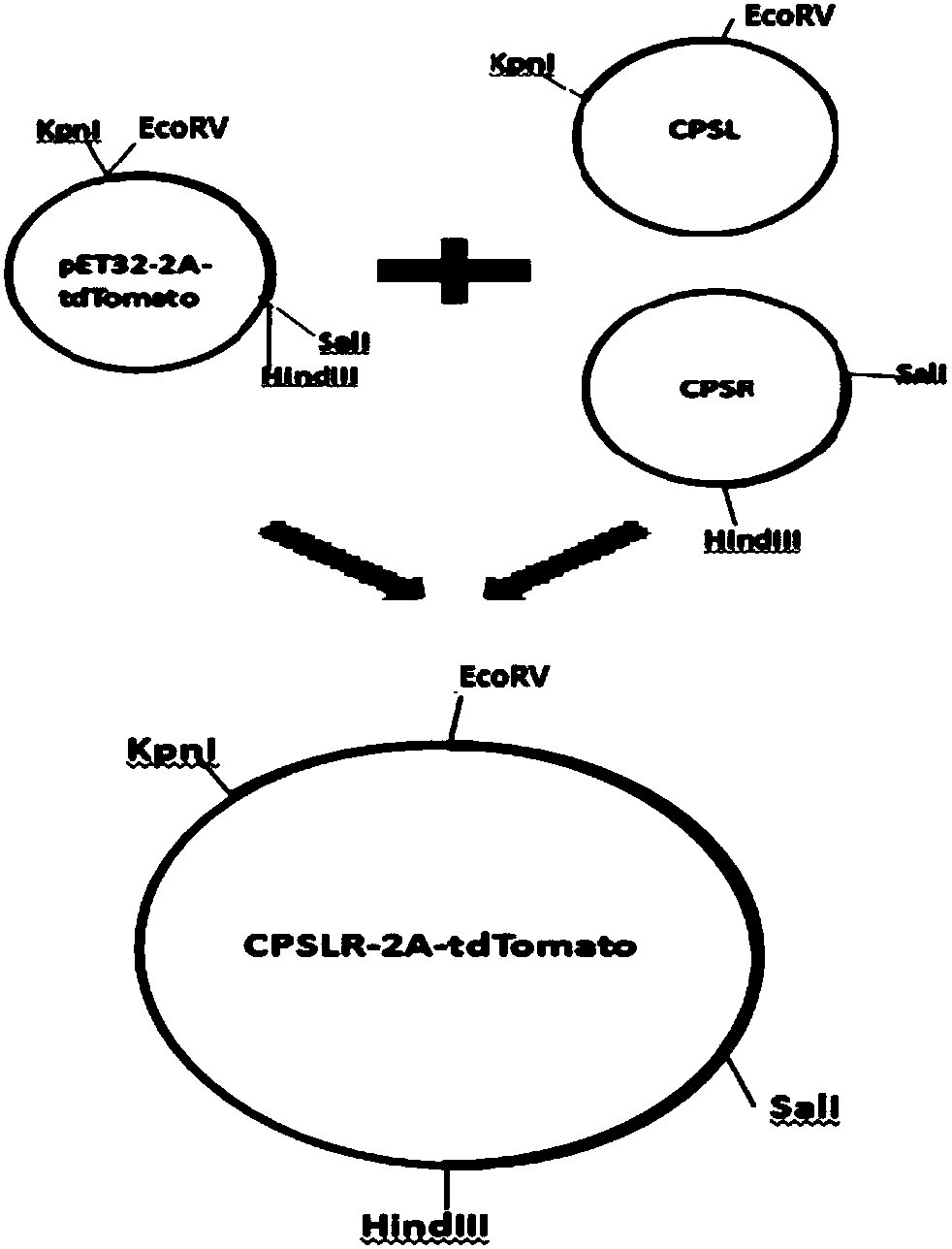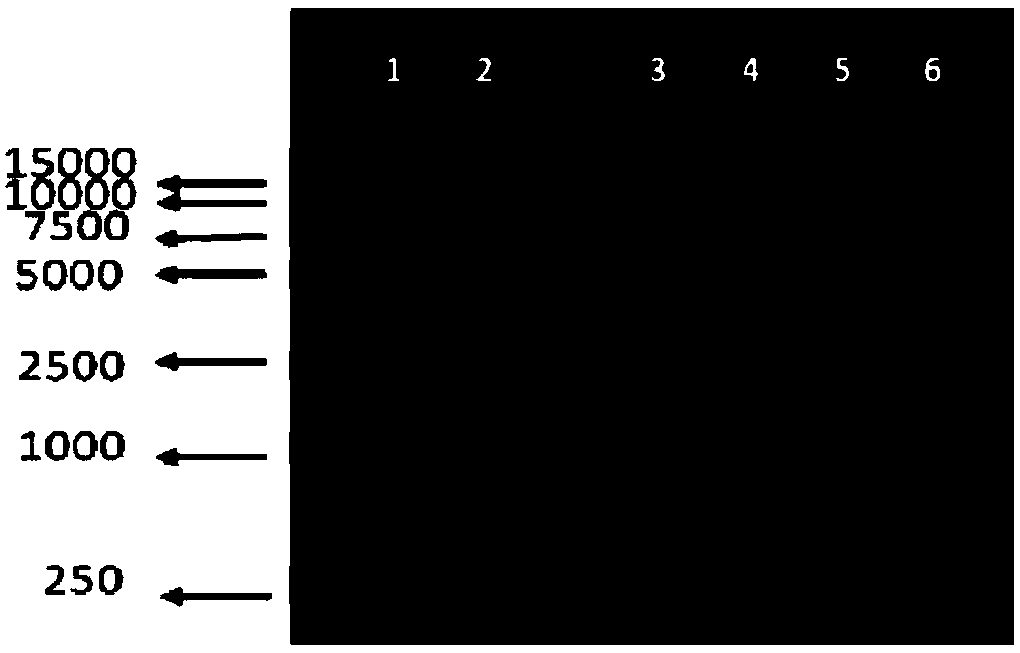CPS1 report gene stem cell, and building method and application thereof
A technology of reporter gene and construction method, which is applied in the field of bioengineering, can solve the problems of low liver cell function, low overall cell function, and lack of intermediate cells, etc., and achieve the effect of high purity
- Summary
- Abstract
- Description
- Claims
- Application Information
AI Technical Summary
Problems solved by technology
Method used
Image
Examples
Embodiment 1
[0052] Embodiment 1, design the single-stranded guide RNA (sgRNA) of carbamoyl phosphate synthetase 1 (CPS1) gene and backbone vector construction
[0053] 1) Design the single-stranded guide RNA (sgRNA) of the carbamoyl phosphate synthase 1 (CPS1) gene by using the sgRNA target design software on the website of MIT Zhang Feng Laboratory (URL: crispr.mit.edu) to identify the CPS1 gene (GenBank number: 1737 ), the target sequence of the CPS1 gene is: AGCTGTGCAGAAATCTCGCA (located at 4759-4778 bases from the 5' end of the CPS1 gene), and a cohesive end that can be digested with Bbs I is added to this sequence The nucleotides that form a pair, the specific sequence is as follows:
[0054] oligo1:5'- CACC AGCTGTGCAGAAATCTCGCA-3',
[0055] oligo2:5'- TTTG ACGCTCTAAAGACGTGTCGA-3';
[0056]The underlined sequence can be complementary to the end of Bbs I digestion. Oligo1 and Oligo 2 contain guide sequence sgRNA, which can form sgRNA with the backbone sequence contained in the to...
Embodiment 2
[0075] Example 2. Construction of the targeting vector pET32-CPSLR-tdTomato of the CPS1 gene
[0076] like figure 2 As shown, this embodiment takes the introduction of the fluorescent group tdTomato as an example to illustrate the construction process of the targeting vector pET32-CPSLR-tdTomato of the CPS1 gene. Include the following steps:
[0077] 1) Design primers for amplification of the CPS1 gene left arm insert (CPSL) and right arm insert (CPSR). The primer sequences are as follows (please provide the following primer sequences):
[0078] CPS1 Gene Left Arm Insert Segment (CPSL) Amplification Primers:
[0079] Forward primer (CPSL-F): 5'-GAAGATCTTTGTGTGAATCTTCAGGAATA-3'
[0080] Reverse primer (CPSL-R): 5'-CGGATATCTGCTGCTTTTCCAGCACTGT-3';
[0081] CPS1 Gene Right Arm Insert Segment (CPSR) Amplification Primers:
[0082] Forward primer (CPSR-F): 5'-ACGCGTCGACAGATGCAGACACCCCAGCC-3'
[0083] Reverse primer (CPSR-R): 5'-CCCAAGCTTGAAGTAATGAAAGTCTTGAC-3'.
[0084] 2) ...
Embodiment 3
[0121] Embodiment 3, construction CPS1-tdtomato reporter gene human embryonic stem cell
[0122]Mix pX458-sgCPS1 (the backbone carrier of the CPS1 gene) and pET32-CPSLR-2A-tdTomato (the targeting carrier of the CPS1 gene) at a ratio of 1:3 (mass ratio), and mix each 10 6 Human embryonic stem cells (hESCs) cells (purchased from WiCell Research Institute, NIH number WA09) were mixed with 2 μg of mixed plasmids, 1050V 30pulse electric shock twice (Life Technology Company), and the cells were resuspended in 2 mL containing 10 μM Rho-related protein kinase inhibitor 200 μg / mL G418 (Neomycin, Gibco Company, Cat. No. 10131035) was added after 24 hours for screening (screening criteria were G418 resistance And normal embryonic stem cell clone growth). After 15 days, 10 G418-resistant clones were obtained, and their genomic DNA was extracted, and oligonucleotides derived from the CPS1 DNA sequence and the tdtomato gene sequence were used as primers (sequence: 5'-GAAGATCT TTGTGTGAATCTT...
PUM
 Login to View More
Login to View More Abstract
Description
Claims
Application Information
 Login to View More
Login to View More - R&D
- Intellectual Property
- Life Sciences
- Materials
- Tech Scout
- Unparalleled Data Quality
- Higher Quality Content
- 60% Fewer Hallucinations
Browse by: Latest US Patents, China's latest patents, Technical Efficacy Thesaurus, Application Domain, Technology Topic, Popular Technical Reports.
© 2025 PatSnap. All rights reserved.Legal|Privacy policy|Modern Slavery Act Transparency Statement|Sitemap|About US| Contact US: help@patsnap.com



